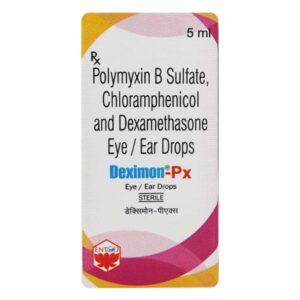CHLORAMPHENICOL + DEXAMETHASONE
Chloramphenicol: Chloramphenicol is an antibiotic medication that is used to treat a wide range of bacterial infections. It belongs to the class of drugs known as bacteriostatic antibiotics, which means it stops the growth of bacteria, allowing the body’s immune system to eliminate the infection.
The mechanism of action of chloramphenicol involves inhibiting bacterial protein synthesis. It does this by binding to the bacterial ribosomes, specifically to the 50S subunit, which prevents the formation of peptide bonds between amino acids. This interference with protein synthesis ultimately stops the growth and proliferation of bacteria.
Chloramphenicol is administered orally or intravenously. The dosage prescribed varies depending on the type and severity of the infection, as well as the patient’s age and overall health. It is important to follow the prescribed dosage and complete the full course of treatment to ensure the bacteria are completely eradicated.
Like any medication, chloramphenicol can cause side effects. The most common side effects include nausea, vomiting, diarrhea, and abdominal pain. Reversible bone marrow suppression is a serious side effect that can occur, which may lead to anemia, leukopenia (reduced white blood cells), and thrombocytopenia (reduced platelets). In rare cases, chloramphenicol can cause a condition known as gray baby syndrome in infants, characterized by pale or ashen gray skin color, hypothermia, poor feeding, and vomiting.
Chloramphenicol also carries a risk of allergic reactions in some individuals. Signs of an allergic reaction may include rash, itching, swelling (especially of the face, tongue, or throat), severe dizziness, and difficulty breathing. If any of these symptoms occur, medical attention should be sought immediately.
It is important to note that Chloramphenicol should only be used under medical supervision and direction. It should not be used in individuals with a history of allergic reactions to the drug, or in certain medical conditions such as liver or kidney disease, unless specifically prescribed and monitored by a healthcare professional.
Dexamethasone: Dexamethasone is a corticosteroid medication that is commonly used to treat a variety of conditions, primarily inflammation and immune-related disorders. It belongs to the class of drugs known as glucocorticoids.
The mechanism of action of dexamethasone involves binding to specific glucocorticoid receptors in the cells, leading to the inhibition of various inflammatory responses. It suppresses the release of substances that cause inflammation, such as prostaglandins and leukotrienes. Additionally, dexamethasone also has immunosuppressive effects by inhibiting the function of immune cells.
Dexamethasone can be administered in several forms, including oral tablets, intravenous injection, intramuscular injection, and topical application. The appropriate dosage and duration of treatment depend on the specific condition being treated, the patient’s response, and other factors determined by the healthcare provider.
Some of the conditions for which dexamethasone is commonly prescribed include allergic reactions, asthma, rheumatoid arthritis, inflammatory bowel disease, lupus, some types of cancer, and various skin conditions such as eczema or psoriasis. It is also frequently used as a supportive treatment for reducing inflammation and improving symptoms in certain noninfectious respiratory conditions, such as COVID-19.
As with any medication, dexamethasone is associated with potential side effects. Common side effects may include increased appetite, weight gain, fluid retention, mood changes, difficulty sleeping, and increased susceptibility to infections. Long-term use or high doses of dexamethasone can lead to more severe side effects, such as adrenal suppression, osteoporosis, muscle weakness, elevated blood sugar levels, and increased risk of infections and gastrointestinal ulcers.
It is important to note that dexamethasone should not be abruptly discontinued without medical supervision, as sudden withdrawal can lead to adrenal insufficiency. Therefore, it is recommended to gradually reduce the dosage as directed by a healthcare professional.
It is crucial to follow the prescribed dose and duration of treatment as improper use of dexamethasone can increase the risk of side effects. Regular monitoring and communication with the healthcare provider are essential while using this medication.

